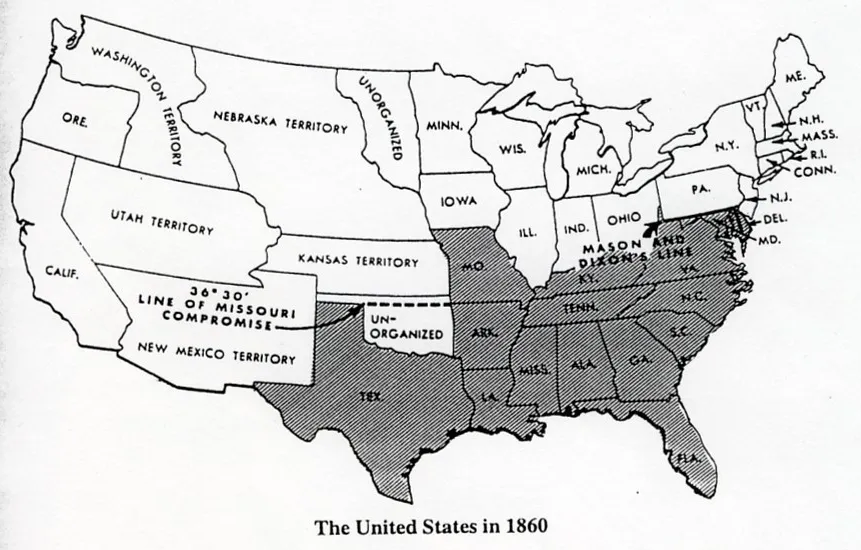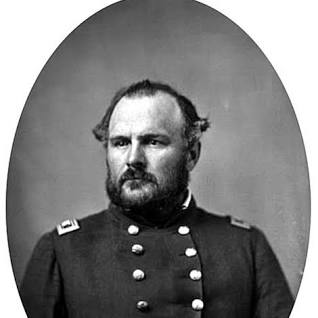Colorado came to be a territory of the United States in a piecemeal fashion. Its present-day eastern and central areas were part of the Louisiana Purchase, made 1803, while the western portion of the state was acquired during the Mexican War (1846-1848) from Mexico, who had gained control over the area in 1833 when it had won its independence from Spain. Even after all the land was firmly under U.S. control, the area was divided. Parts of present-day Colorado were included in New Mexico and Utah Territories, both organized in 1850. Others were of Kansas and Nebraska Territories, organized in 1854.
Until the late 1850s, when gold was discovered in Russellville Gulch in present-day Douglas County and along Cherry Creek near where it joins with the Platte River, Colorado only had about 7,500 settlers. By 1859, an estimated 100,000 men had entered the gold fields. Because many of these men came from Georgia and other southern states, the area had a distinctive lean towards southern sympathies.
Until the late 1850s, when gold was discovered in Russellville Gulch in present-day Douglas County and along Cherry Creek near where it joins with the Platte River, Colorado only had about 7,500 settlers. By 1859, an estimated 100,000 men had entered the gold fields. Because many of these men came from Georgia and other southern states, the area had a distinctive lean towards southern sympathies.
Five days before Abraham Lincoln became President on 4 March 1861, his predecessor, James Buchanan signed the law that made Colorado a Territory. Two weeks after his inauguration Lincoln, who wanted a pro-Union governor for Colorado Territory, proposed William Gilpin to the Senate, who appointed him, but then recessed before passing any appropriations for the new Territory. Gilpin was left with just a $1,500 contingency fund with which to run the new territory. He arrived in Denver before June and toured the mining camps, discovering that the boom had passed and a new census showed only about 25,000 people including 4,000 white females and 89 Negroes in the territory, most of them concentrated in the Clear Creek, Boulder, and South Park mining districts and in the small but growing town of Denver.
On April 12, Confederate forces fired on Ft. Sumter. The U.S. government’s focus shifted to calling up troop in the east, and the needs of Colorado was forgotten. Concerned that the Confederacy would try to conquer the territory for its vast mineral deposits as well as its strategic location, Gilpin began organizing the Territorial military that summer. Morton C. Fisher, his newly appointed Purchasing Agent, was immediately sent out to buy and collect all the arms he could, both supply the new troops and to keep those arms out of the hands of Southern sympathizers. Not having the money to organize and equip the men, Gilpin issued $375,000 worth of drafts, known as Gilpin Scrip, directly upon the United States Secretary of the Treasury. These drafts were used as money in the Territory and were passed along to Washington, who honored payment for some of the script at a value considerably below face value. A year later, this illegal action would cost him his position as Territorial Governor, and he was forced to resign the next year.
On April 12, Confederate forces fired on Ft. Sumter. The U.S. government’s focus shifted to calling up troop in the east, and the needs of Colorado was forgotten. Concerned that the Confederacy would try to conquer the territory for its vast mineral deposits as well as its strategic location, Gilpin began organizing the Territorial military that summer. Morton C. Fisher, his newly appointed Purchasing Agent, was immediately sent out to buy and collect all the arms he could, both supply the new troops and to keep those arms out of the hands of Southern sympathizers. Not having the money to organize and equip the men, Gilpin issued $375,000 worth of drafts, known as Gilpin Scrip, directly upon the United States Secretary of the Treasury. These drafts were used as money in the Territory and were passed along to Washington, who honored payment for some of the script at a value considerably below face value. A year later, this illegal action would cost him his position as Territorial Governor, and he was forced to resign the next year.
Gilpin’s intent was to use the money to create the First Regiment of volunteers consisting of ten companies. He appointed John P. Slough to be its Colonel and Samuel F. Tappan, to be Lt. Colonel. Gilpin had planned for John M. Chivington, an elder of the Methodist Episcopal Church, to be the Chaplain, but when Chivington turned down the appointment and requested a fighting commission, he was made Major. The troops were ordered to Camp Weld, a new installation being built about two miles south of Denver. Gilpin’s Script paid for the building of Camp Weld as well as uniforms, arms, supplies and equipment for the troops.

One of the first men to join Gilpin’s new militia was Samuel H. Cook, who convinced 80 men from the gold fields of the South Clear Creek mining district to join with him on a ride to Kansas, where they would join the Union Army and serve under General James Lane. As they were passing through Denver in the middle of August, Cook met Governor Gilpin, who persuaded him to remain in Colorado and join what was becoming the First Regiment of the Colorado Volunteers. Cook’s men became a mounted troop, designated as Company F.
In December of 1861, news came from New Mexico that Confederate troops under H.H. Sibley had invaded over the Texas border, two companies of Colorado Volunteers set out for New Mexico. These companies were Captain Theodore H. Dodd’s Independent Company, Colorado Volunteers and Captain James H. Ford’s Independent Company, Colorado Volunteers. Dodd’s Company was sent to Fort Craig, where they resisted a charge of lancers in the battle of Valverde on February 21, 1862. Ford’s Company was sent to Taos and then Santa Fe before being ordered back to Ft. Union.
On February 14, 1862 orders arrived that asked that all available forces that Colorado could spare be sent south to aid Colonel Canby, the commander of the Department of War in New Mexico. On February 22, the main body of the First Colorado Regiment, including Captain Cook’s Co. F, set out amid intense snow storms. They arrived at Fort Union on March 10th and were joined the next day by Ford’s Company. Slough would march most of these men south, where they participated in the Battle of Glorieta before joining forces with Canby to shepherd the retreating Confederates back to their own territory, ensuring that both New Mexico and Colorado Territories would remain in Union hands.
On February 14, 1862 orders arrived that asked that all available forces that Colorado could spare be sent south to aid Colonel Canby, the commander of the Department of War in New Mexico. On February 22, the main body of the First Colorado Regiment, including Captain Cook’s Co. F, set out amid intense snow storms. They arrived at Fort Union on March 10th and were joined the next day by Ford’s Company. Slough would march most of these men south, where they participated in the Battle of Glorieta before joining forces with Canby to shepherd the retreating Confederates back to their own territory, ensuring that both New Mexico and Colorado Territories would remain in Union hands.
Jennifer Bohnhoff's trilogy, Rebels Along the Rio Grande, is written for middle grade readers who are interested in the Civil War in New Mexico.









No comments:
Post a Comment